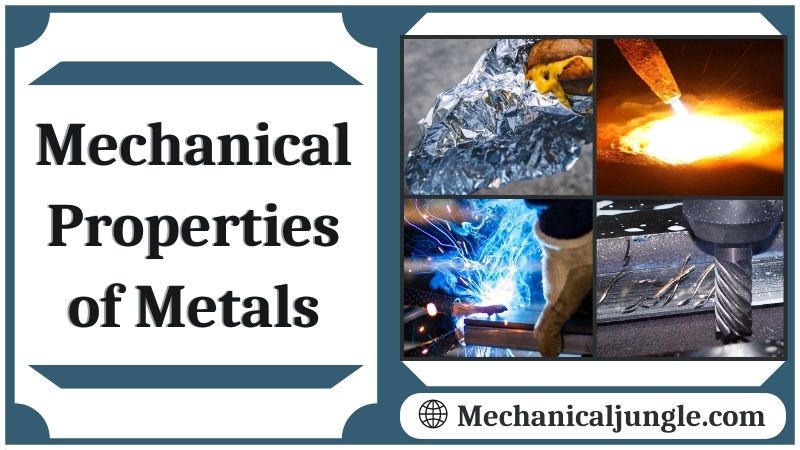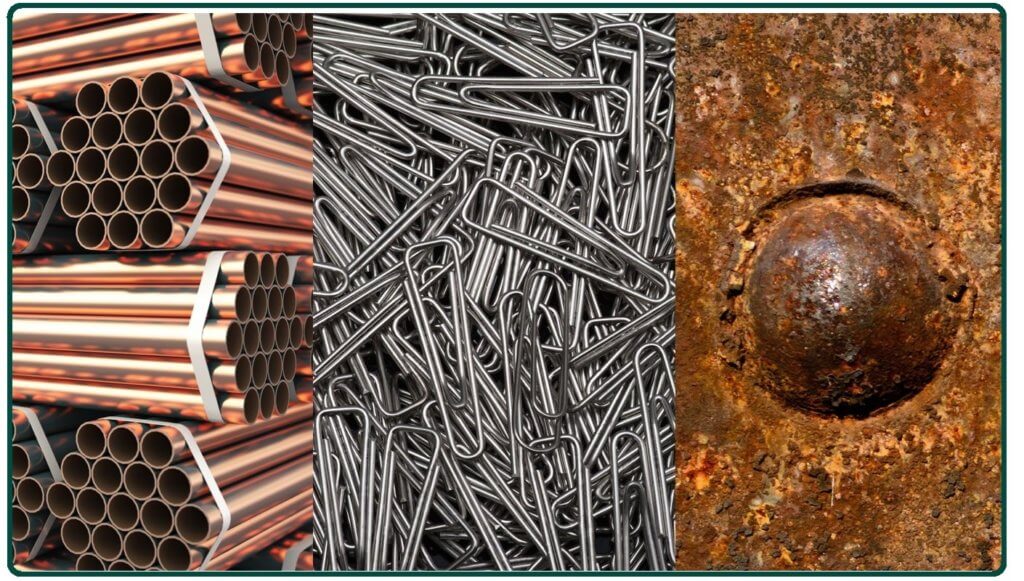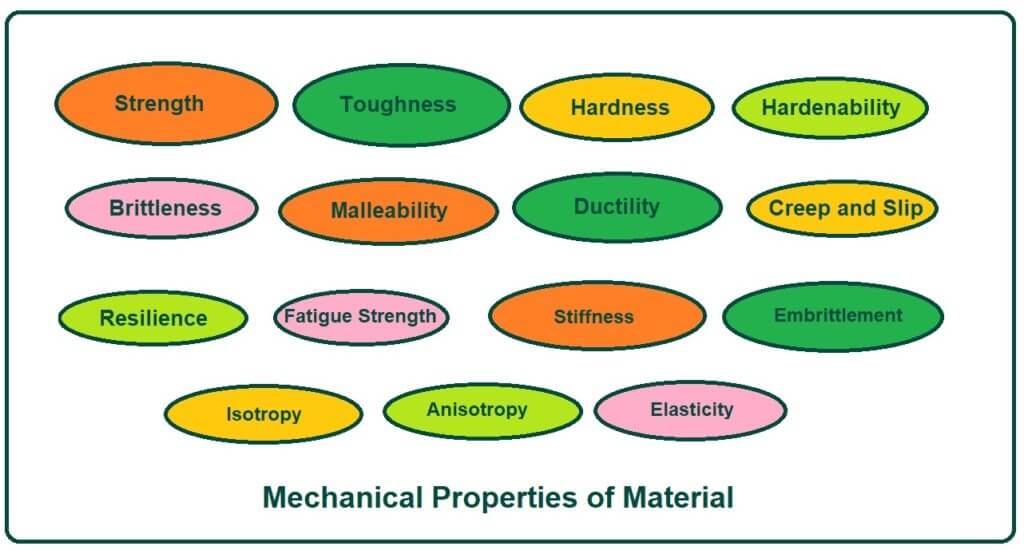
What Are the Mechanical Properties of Metals?

Often welded structures and products are subject to a certain amount of force. How can one ensure that his welding work does not fail under pressure?
While it is important to know how to set up an arc and handle electrodes, understanding the mechanical properties of the material being used can ensure the strongest, toughest weld possible.
The design of any machine element will be started with the selection of the material and the study of the mechanical properties of the material. Following are the various mechanical properties of the material. Let’s look at each of them.
Mechanical Properties of Material:

In order to finalize a material for an engineering product or application, it is important to understand the mechanical properties of the materials.
Mechanical properties of the material are those that affect a material’s mechanical strength and ability to be molded into a suitable shape. Some typical mechanical properties of the material include:
- Strength
- Toughness
- Hardness
- Hardenability
- Brittleness
- Malleability
- Ductility
- Creep and Slip
- Resilience
- Fatigue Strength
- Stiffness
- Embrittlement
- Isotropy
- Anisotropy
- Elasticity
#1. Strength
It is the property of materials to resist deformation or breakage of the material in the presence of external forces or loads. The materials that we finalize for our engineering products must have the suitable mechanical strength to be able to operate under various mechanical forces or loads.
#2. Toughness
It is the ability of materials to absorb energy and deform plastically without fracture. Its numerical values are determined by the amount of energy per units volumes. Its unit is joule/m3. The value of the Hardness of a material can be determined by the stress-strain characteristics of a material.
For good toughness, the material must have good strength as well as ductility. For example, brittle materials, which have good strength but limited ductility, are not hard enough.
In contrast, materials with good ductility but low strength are also not hard enough. Therefore, in order to harden, the material must be able to withstand both high stress and strain.
#3. Hardness
It is the ability of materials to resists permanents shape change due to external stress. There are different measures of Hardness – scratch hardness, indentation hardness, and rebound hardness.
Scratch Hardness:-
Scratches Hardness is the ability of materials to resist scratches on the outer surface layer due to an external force.
Indentation Hardness:-
It is the ability of materials to resist dents caused by the punch of hard and sharp objects outside.
Rebound Hardness:-
Rebound stiffness is also called dynamic stiffness. It is determined by the height of the “bounce” of a diamond-tipped hammer dropped from a certain height on the material.
#4. Hardenability
It is the ability of materials to achieve Hardness by heat treatment processing. It is determined by the depth to which the material hardens. The SI unit of Hardness is the same meter in length. The Hardness of a material is inversely proportional to the weldability of the material.
#5. Brittleness
The brittleness of a material indicates how easily it breaks when subjected to force or load. When brittle materials are subjected to stress, it observes very little energy & tends to fracture without significant stress. Brittleness is the opposite of the ductility of a material.
The brittleness of the material is temperature-dependent. Some metals that are ductile at normal temperatures become brittle at low temperatures.
#6. Malleability
Malleability is a property of solids that indicates how easily a material deforms under compressive stress. Resilience is often classified by the ability of a material to form thin sheets by hammering or rolling. These mechanical properties are an aspect of the plasticity of the material.
The ductility of the material is temperature-dependent; with increasing temperature, the ductility of the material increases.
#7. Ductility
Ductility is the properties of a solid material that indicates how easily the material deforms under tensile stress. Tensile is often classified on the basis of the ability of a material to be stretched or pulled into a wire by stretching.
These mechanical properties are also an aspect of the plasticity of the material and are temperature-dependent; with increasing temperature, the ductility of the material increases.
#8. Creep and Slip
Creep is a property of a material that indicates the tendency of the material to move slowly & deform permanently under the influence of external mechanical stress. This is due to the large external mechanical stress over a long period of time within the yield range.
The creep is more severe in materials that have been subjected to heat for a long time. A slip in a material is a plane with a high density of atoms.
#9. Resilience
Resilience is the ability of materials to absorb energy when it is elastically deformed by applying stress and release energy when the stress is removed. Proofs resilience is defined as the maximum energy that can be absorbed without permanent deformation.
The modulus of ductility is defined as the maximum energy that can be absorbed per unit volume without permanent deformation. This can be determined by integrating the stress-strain curve from zero to the elastic limit. Its unit is joule/m3.
#10. Fatigue Strength
Fatigues are the weakening of the materials due to repeated loading of the material. When materials are subjected to cyclic loading and loading exceeds a certain limit value but is much lower than the material’s strength, the ultimate tensile strength limit or yield stress limit, microscopic cracks may form at grain boundaries and interfaces.
Eventually, the crack reaches a critical size. This crack suddenly expands, and the structure breaks down. The shape of the structure greatly affects fatigue. Square holes and sharp corners increase stress where fatigue crack begins.
#11. Stiffness
The ability of materials to resist significant elastic deformation while under load. The less deformation material exhibits during loading, the harder it is.
#12. Embrittlement
Due to chemical or physical changes, the metal loses its ductility and becomes brittle.
#13. Isotropy
Often confused with isotropic material, isotropic material exhibits similar properties in any direction or orientation, whereas homogeneous materials have similar properties regardless of direction.
#14. Anisotropy
A material exhibits different properties depending on its direction or orientation. For example, in computer graphics, an anisotropic surface changes appearance depending on the angle at which it is being displayed.
#15. Elasticity
A material that returns to its original dimensions after deformation or is removed by its weight. Each material has a certain elastic limit before it is permanently deformed, otherwise known as plasticity deformation.
Frequently Asked Questions (FAQ)
What are the key mechanical properties of metals that influence welding strength?
The key mechanical properties of metals that influence welding strength include strength, toughness, hardness, hardenability, brittleness, malleability, ductility, creep and slip, resilience, fatigue strength, stiffness, embrittlement, isotropy, anisotropy, and elasticity.
Why is toughness important in welding?
Toughness is important in welding because it indicates the material’s ability to absorb energy and deform plastically without fracturing. Materials with good toughness can withstand both high stress and strain, making them suitable for applications where impact resistance is crucial.
How does hardness affect welded structures?
Hardness affects welded structures by determining their resistance to permanent shape change due to external stress. Higher hardness means better resistance to wear and indentation, which is essential for maintaining the integrity of welded joints under mechanical loads.
What is the difference between brittleness and ductility?
Brittleness refers to the tendency of a material to fracture without significant deformation when subjected to stress, while ductility is the ability of a material to deform plastically under tensile stress without breaking. Brittleness is the opposite of ductility.
How does temperature impact the ductility of metals?
Temperature has a significant impact on the ductility of metals. As temperature increases, the ductility of most metals also increases, allowing them to deform more easily without breaking. Conversely, some metals may become brittle at low temperatures.
What is creep, and why is it important in engineering applications?
Creep is the tendency of a material to deform permanently under the influence of long-term mechanical stress. It is important in engineering applications because it can affect the performance and longevity of materials and structures that are subjected to constant stress over extended periods.
Can you explain the concept of fatigue strength?
Fatigue strength refers to the weakening of materials due to repeated cyclic loading. When a material is subjected to cyclic stress below its ultimate tensile strength, microscopic cracks can form and eventually lead to failure. Understanding fatigue strength is crucial for designing components that can withstand repeated loading without breaking.
What is the significance of anisotropy in materials?
Anisotropy is significant because it indicates that a material exhibits different properties depending on its direction or orientation. This characteristic can affect the material’s performance in various applications, making it important to consider anisotropy when designing and selecting materials for specific uses.
How does elasticity contribute to the mechanical properties of metals?
Elasticity contributes to the mechanical properties of metals by allowing them to return to their original dimensions after deformation when the stress is removed. Each material has an elastic limit beyond which it will undergo permanent deformation. This property is essential for applications requiring materials to withstand temporary loads without permanent damage.
What is hardenability, and how is it measured?
Hardenability is the ability of a material to achieve hardness through heat treatment processing. It is measured by the depth to which the material hardens. The greater the hardenability, the deeper the hardness penetration, which is crucial for components that require a hard surface and a tough core.

